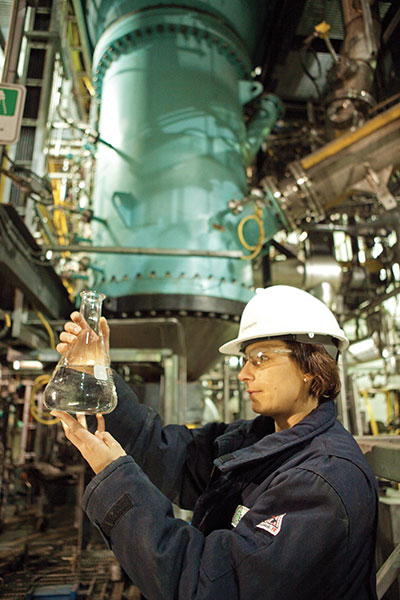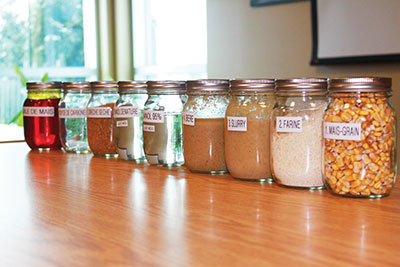
Waste reduction
March 24, 2014
By Treena Hein
It’s a very positive development for Canada that as crops, trees and the amount of municipal waste continue to grow, so does our national ethanol production.
It’s a very positive development for Canada that as crops, trees and the amount of municipal waste continue to grow, so does our national ethanol production. And more and more facilities are now being built that can accept woody biomass and solid waste materials as feedstocks to produce cellulosic ethanol.
 |
|
| The waste to biofuel technology developed by Enerkem is at display in a demonstration facility in Westbury, Quebec.
|
“Canadian Renewable Fuel Association members are integrating new technologies into their renewable fuels platforms as well as building first-in-kind standalone facilities,” notes CRFA President W. Scott Thurlow. One of these unique high-tech facilities will be constructed starting later this year in Varennes, Quebec near Montreal. The state-of-the-art waste-to-biofuels cellulosic ethanol facility is a joint 50/50 venture between Enerkem and GreenField Specialty Alcohol, christened VANERCO.
The government of Quebec is contributing $27 million to the project. In October 2013, the federal government (through Sustainable Development Technology Canada’s (SDTC) ‘NextGen Biofuels Fund’) contributed $734,500 as a repayable contribution. However, repayable SDTC funding could reach almost $40 million, based on subsequent project milestones.
“Several activities related to VANERCO project development and site preparation are currently taking place,” says Marie-Hélène Labrie, Enerkem’s vice president of communications. “Construction is currently planned to begin in the second half of 2014 and should be completed approximately 18 months later.” The facility, operated by GreenField and using Enerkem technology, will employ between 30 to 40 engineers, technicians, operators and other staff.
In addition to diverting solid waste from landfills, the plant will reduce the province’s greenhouse gas emissions by about 110,000 metric tonnes of CO2 every year. It will help in meeting the government of Québec’s commitment to reduce GHG emissions to 20 per cent below 1990 levels by 2020, under the province’s 2006-2012 Climate Change Action Plan.
With a full-scale waste-to-biofuels facility under commissioning in Edmonton and another one under development in Mississippi, VANERCO is part of Enerkem’s first wave of full-scale commercial projects. The company currently operates both a pilot and a commercial-scale demonstration facility in Québec as well. Labrie explains that the Edmonton facility is the very first collaboration in the world between a waste-to-biofuels producer and a metropolitan centre (the City of Edmonton) to address waste disposal challenges. It will be operational by summer 2014.
But Enerkem is not planning to stop there in its quest to convert more municipal solid waste into biofuels and chemicals. “We see increased interest from cities to reduce landfilling and from large industrial groups, including chemical groups, to develop sustainable energy solutions and produce greener everyday products,” says Enerkem director of communications Annie Paré. “I can certainly tell you that Enerkem is currently developing additional biorefineries in North America and globally, but I cannot provide more details at this stage, unfortunately.”
Being located on the site of an existing GreenField ethanol plant, the Varennes project is unique in that it represents one of the first integrations between an existing, first generation ethanol plant and a new cellulosic ethanol plant. “By building and integrating this advanced biofuels facility at GreenField’s current first-generation ethanol production site, we will be able to capture synergies with respect to roads, utilities and customers for example,” says Paré.
Jean Roberge, general manager at GreenField Specialty Alcohols’ Varennes plant, adds: “the plants will physically be interconnected to share things such as energy, chemicals, ethanol storage and other similar services. In addition, all of the GreenField existing facilities such as infrastructure, laboratory, maintenance shop and offices will be shared between the projects.”
Feedstock and production
The VANERCO feedstock will consist of a wide variety of sorted non-recyclable industrial, commercial and institutional solid waste, in addition to construction and demolition debris. Enerkem’s proprietary thermochemical technology converts mixed textiles, plastics, fibers, wood and other non-recyclable waste materials into chemical-grade syngas, and then into ethanol (38 million litres per year).
Enerkem technology can also produce methanol and other chemical intermediates that form everyday products. “Methanol has many uses in the chemical industry,” says Pare. “It is also used for windshield washer fluid. The other chemical intermediates that Enerkem is looking to develop in the future are used in products such as textiles, coatings, adhesives and paints, to name a few.” She references a ‘Chemical Markets Report’ from 2013 that says the renewable chemicals market is estimated to reach US$59 billion in 2014. It was US$45 billion in 2009.
“The cellulosic ethanol produced in VANERCO will be distributed by GreenField to refiners and blenders,” says Labrie. “They are required, by mandate, to include a five per cent minimum content (on average) of renewable fuels, such as cellulosic ethanol, in their gasoline pool.”
The first phase of the Enerkem process is auto-thermal, explains Labrie. “This means that the chemical reaction creates the energy needed. Also Enerkem uses low temperature and pressure to operate its system. Overall, Enerkem’s process produces more than four times the energy required to operate. This means for one unit of energy used to operate the plant, we produce four units of usable energy in the form of ethanol as transportation fuel.”
Ethanol diversification
At the first-generation GreenField Specialty Alcohols plant on site in Varennes, built in 2006 and employing 52, staff produce 175 million litres of ethanol per year from 12 million bushels of feed corn. GreenField has the leading market share of industrial alcohol and is the largest ethanol producer in Canada. Its Varennes plant also produces 140,000 tonnes of Dried Distillers Grains with Solubles (DDGS) and 70,000 tonnes of Wet Distillers Grains (WDGS), returned to farmers for use as animal feed. Other products include CO2 valorized in dry ice, and corn oil. The federal government contributed $18 million towards construction.
 |
|
| GreenField produces a variety of products including ethanol, corn oil and dried and wet distillers grains that are returned to farmers for use as animal feed.
|
SEMECS, a private company formed by three local regional municipalities and Biogaz EG, (GreenField’s subsidiary in anaerobic digestion) recently announced plans for the implementation of a 50,000 tonnes-per-year anaerobic digestion plant at Varennes. Feedstock will consist of municipal organic waste (‘brown bin’ collection) as well as organic commercial and industrial waste. GreenField Varennes will be the off-taker for the bio-methane and the digestate will be used by local farmers as fertilizer.
A digester is also in the works at Kawartha Ethanol, a plant that began operation north of Peterborough in Havelock, Ontario in 2011. Corn is used to produce about 80 million litres of ethanol per year (all purchased by MacEwen Petroleum of Maxville, Ontario), as well as WDGS. Approval for the digester project (called Kawartha Biogas) came in April 2013 from the Ontario Ministry of Environment. The 9.8 MW digester will be able to accept feedstocks such as WDGS, ethanol syrup, glycerin from proposed bio-diesel facility on the same site, manure, whey from dairy farms, as well as locally-sourced organic matter, fats and grease.
This use of digesters is of course, part of a bigger diversification/synergy trend at ethanol plants across Canada and beyond. For example, GreenField recently installed a greenhouse at its ethanol plant in Chatham, Ontario, in collaboration with established vegetable producer Cedarline. The ‘Truly Green’ project utilizes waste heat and CO2 from the ethanol plant to grow over 20 million kilograms of fresh tomatoes each year.
At another site, GreenField sells steam to Bruce Power, which operates the Bruce Nuclear Generating Station in Tiverton, Ontario. GreenField also extracts corn oil that today goes to the biodiesel market. Other valuable proteins, fibres and minerals in corn can also be extracted.
And the market for ethanol itself will only continue to expand. In terms of cellulosic ethanol production in Canada at this point, the Canadian Renewable Fuel Association reports that an Iogen demo plant currently runs on occasion and both GreenField and Lignol have pilot plants in part-time operation. In addition to the Enerkem Edmonton plant under construction, and the VANERCO plant in development, U.S.-based Mascoma is also developing a cellulosic ethanol plant in Canada (to use woody biomass).
“We at Enerkem believe that the demand for cellulosic ethanol will continue to grow in the coming years,” says Labrie. “The advanced ethanol market is driven by a number of factors such as government policies, private investments, infrastructure development such as higher ethanol blends, as well as technologies reaching the commercial deployment phase.”
She says consumers are continuing to ask for more choice at the pump while car manufacturers are working to improve fuel economy, an area in which ethanol can certainly help by delivering high octane ratings and lower emissions. “We equally observe a high level of interest and a growing demand on international markets for advanced biofuels and renewable chemicals,” Labrie adds. “Moreover, ethanol should continue to be cheaper than gasoline.”
Print this page